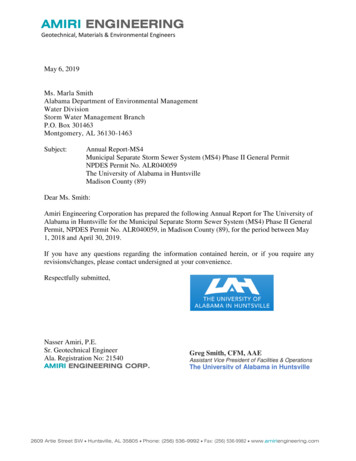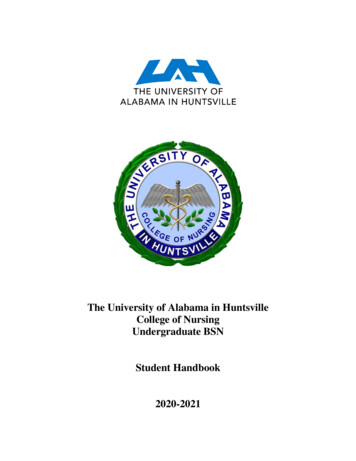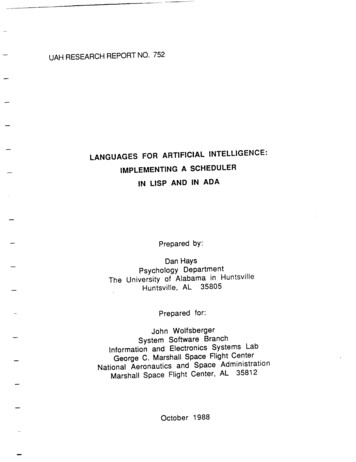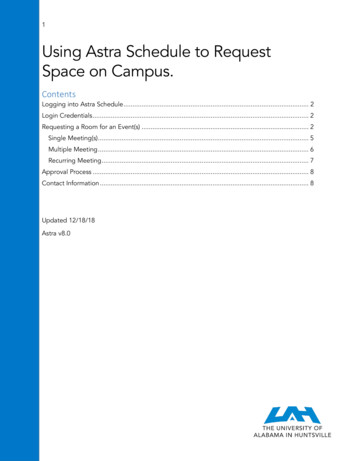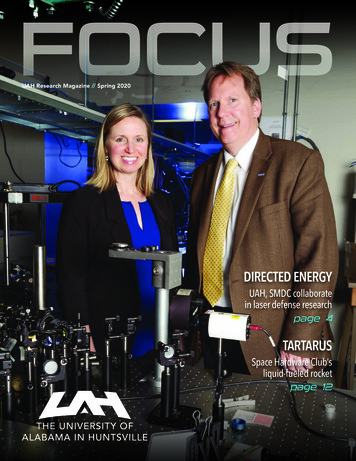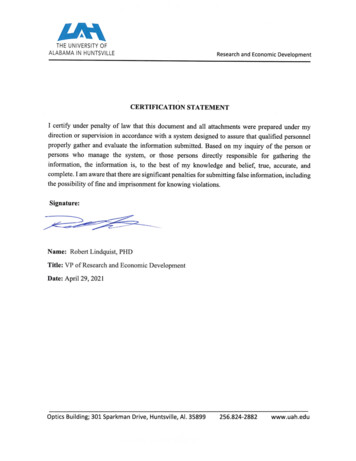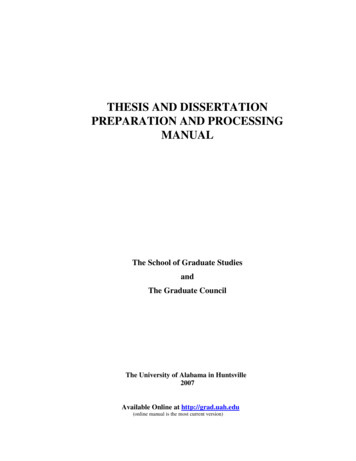
Transcription
THESIS AND DISSERTATIONPREPARATION AND PROCESSINGMANUALThe School of Graduate StudiesandThe Graduate CouncilThe University of Alabama in Huntsville2007Available Online at http://grad.uah.edu(online manual is the most current version)
September 2007Dear Student:As you begin the process of preparing your thesis or dissertation I would like to remindyou that this document is one of the most important requirements for your graduate degree. It is aunique document, generally much more detailed than a journal publication, yet still focused on aparticular research area. It is the one chance you get to completely describe all your researchefforts and their results. This document will be published as a product of the University ofAlabama in Huntsville and as such must reflect the standards, policies and procedures set forth bythe Graduate Council of UAH, as well as those of external entities that will be involved in itspublication. We expect these documents to be reasonably consistent in style and format, toaddress any legal and ethical issues related to conducting and publishing original research, and toadhere to the highest standards of English language, grammar and readability.Preparation of such an important document is no simple task. Therefore, this Manual isbeing provided to assist you. A great deal of time, thought, and effort on the part of manyindividuals has gone into its preparation, and I urge you to read it thoroughly before embarkingon your thesis- or dissertation-writing journey. A clear understanding from the outset of theguidelines and requirements set forth within this Manual could well save you considerable timeand effort as the deadline for submission approaches. Furthermore, the lessons learned will serveyou well in future scholarly endeavors, both within academe and beyond.While every attempt has been made to cover or anticipate most issues dealing with thepreparation of your thesis or dissertation, there may well be areas where problems or questionsarise. Also, colleges, departments, and even individual advisors may have more specificguidelines than those contained in this Manual. I therefore encourage you to consult with youradvisor early and often in the writing process. However, the Dean of the School of GraduateStudies is the final authority as to the acceptability of a thesis or dissertation, and I will be happyto deal with any issues if and when they arise.Best wishes,Debra M. Moriarity, Ph.D.Dean, School of Graduate Studiesii
AcknowledgmentsThe School of Graduate Studies wishes to acknowledge the efforts of the Thesisand Dissertation Manual Committee and others who have contributed to this completeupdate and revision of the UAH Thesis and Dissertation Manual.The Committee consisted of Dr. Julie English Early, Committee Chair, Collegeof Liberal Arts; Dr. Gordon Emslie, Dean of the School of Graduate Studies (ex officio);Dr. Marsha Dowell, College of Nursing; Dr. Kenneth Howell, College of Science;Ms. Chantell Marsh, Thesis and Dissertation Reviewer; and Dr. Richard Wyskida,College of Engineering.University Counsel Robert Rieder and the Council of Deans also reviewed theManual.Additional revisions were completed in 2007 by Dr. Debra Moriarty, Dean of theSchool of Graduate Studies; Chantell Marsh, Thesis and Dissertation Reviewer; and JaneStormer, Administrative Assistant, School of Graduate Studies.iii
Table of ContentsAcknowledgments .iiiThe Plan of the Manual .1Part OneWHAT YOU SHOULD KNOW BEFORE YOU BEGINChapter One.3Formal Requirements for an Approved Thesis or DissertationStyle .3Documentation .4Formatting .6Overview: the Steps in the Process to an Approved Thesis or Dissertation .6Chapter Two .9Legal and Ethical IssuesPlagiarism.9Copyright.9Patents .11Protection of Human and Other Animal Subjects .11Classified Material .12Part TwoWRITING THE THESIS OR DISSERTATIONChapter Three .14Organizing and Formatting the Document as a WholeOrganizing Information .14Formatting Your Text as a Whole .15Overview: the Parts of the Document .17Chapter Four .18Style and Format within a ChapterFormatting the First and Subsequent Pages.18Headings and Subheadings.19Paragraphs .19Prose Conventions.20Quotations .21Citation .22Mathematics .23Tables, Figures, and Photographs.25iv
Chapter Five .29Back Matter: Supporting and Reference MaterialAppendices .29Reference or Works Cited List .30Bibliography.31Chapter Six.32Front Matter: Preliminaries to the TextTitle Page.33Copy Permission Page.33Approval Page .33Abstract .33Acknowledgments .34Table of Contents .34List of Figures, List of Tables, List of Symbols.35Dedication .35Other Pages .35Part ThreeFINAL PROCEDURESChapter Seven .37Submitting Final Approved CopiesCopies .37Additional Pages.37Forms .37Fees.38AppendicesAppendix A.39Frequent ErrorsAppendix B.42Degree and Department/Program TitlesAppendix C.44Sample PagesAppendix D.67The Council of Graduate Schools, A Policy Statement on the Role and Nature of the DoctoralDissertationAppendix EPatent Laws.69Index.72v
The Plan of the ManualThis manual specifies the requirements for all theses and dissertations submitted to the Universityof Alabama in Huntsville School of Graduate Studies. It outlines legal and ethical issues anddetails professional standards for scholarly publication by defining features of style,documentation, and formatting required for a UAH thesis or dissertation.“Style” refers to English grammar and usage, punctuation, and standard publishingconventions. “Documentation” refers to the system you use for in-text citation or notes and yourreferences, works cited, or bibliography. “Formatting” refers to page layout, document design,and organization.Before you begin to write, you must become familiar with both legal and formalrequirements. As you work, you should consult this manual and the reference sources werecommend. However, please note: should practices in a reference source conflict with thosespecified in the Manual, UAH requirements take precedence. Previous UAH theses anddissertations may be useful as general guides. However, because standards and practices change,we caution you against using them as templates. Your manuscript must conform to the standardsspecified in this edition of the Manual.Attending to standards in the Manual and recommended reference sources will save youthe frustration of learning correct forms and practices when you are facing deadlines, andcorrecting and reprinting a part or all of your manuscript before the School of Graduate Studieswill approve it. The School of Graduate Studies employs a thesis and dissertation reviewer toensure that your document meets the standards specified here.To guide you in producing an acceptable thesis or dissertation, we have organized theManual as an instructional manual to address first, the issues that you must consider before youbegin your project, and then the specifications that you will incorporate during the process ofwriting a thesis or dissertation. Part One defines the elements of professional writing—style, documentation, and formatting.Chapter One directs you to disciplinary reference sources and outlines the thesis ordissertation approval process. Chapter Two alerts you to legal and ethical issues that youmust consider before you begin writing; Part Two addresses issues that arise according to the sequence of writing. It takes you, inChapter Three, through organizing and formatting the document as a whole and, inChapter Four, through specific features that arise as you write a chapter. Chapter Fiveinstructs you in preparing supplementary and reference materials (back matter) andChapter Six, prefatory materials (front matter) for the document; Part Three specifies the final steps in submitting approved copies of the document; Appendices provide examples and material for quick reference; An index directs you to subject information throughout the Manual.1
Questions regarding the format and organization of a thesis or dissertation not addressedin the Manual may be directed to the School of Graduate Studies.2
Part OneWhat You Should Know before You Begin3
Chapter OneFormal Requirements for an Approved Thesis or DissertationStyleLanguage and writing reference worksPublishing conventionsDocumentationGeneral guidesAuthoritative documentation guidelinesFormattingOverview: the Steps in the Process to an Approved Thesis or DissertationAdvisor responsibilitiesStudent responsibilitiesThe Approval processThis chapter defines the categories of formal standards—style, documentation, and formatting—applicable to a UAH thesis or dissertation, and outlines the steps in the approval process.StyleAs a scholarly publication, a thesis or dissertation must cohere in clarity, tone, and English usagewith the standards of professional publication in your discipline, outlined in professionalguidelines and represented, for example, by its principal journals or presses.Language and writing reference worksYou may refer to any standard grammar and punctuation handbook and use any standarddictionary.For grammar and punctuation, we recommend Diana Hacker, A Writer’s Reference,6th ed. (Boston and NY: Bedford/St. Martin’s, 2007). 1For achieving an effective professional prose style, we recommend Joseph M. Williams,Style: Toward Clarity and Grace (Chicago: U of Chicago P, 1998).If you need to acquire a dictionary, we recommend The American Heritage Dictionary,Webster’s Third New International, or The Random House Dictionary. The most recent nonabridged editions include scientific and technical terms, but should be supplemented by glossariesof specialized terms published by governing bodies in many disciplines. If glossaries have notbeen developed for your discipline, check spelling of terms against published books or journals inyour field.1As a document about writing, the Manual uses the most relevant and appropriate documentationstyle, MLA, rather than a form used in the sciences. This includes MLA practice forabbreviations for example, on this page, “P” for Press.4
Publishing conventionsA thesis or dissertation must comply not only with standard American English usage andprofessional standards of your discipline, but also with standard publishing conventions. Suchconventions include a host of copy-editing matters reflecting a level of correctness andconsistency for publishable copy that scholarly writers early in their careers may not havepreviously encountered.Among publishers, the most widely used standards are those of The Chicago Manual ofStyle, 15th ed. (Chicago: U of Chicago P, 2003). For a shorter version of The Chicago Manual,specifically tailored to common problems in theses and dissertations, see Kate L. Turabian, AManual for Writers of Term Papers, Theses and Dissertations, 6th ed. Rev. by John Grossmanand Alice Bennett (Chicago: U of Chicago P, 1987).For UAH theses and dissertations, The Chicago Manual’s guidelines for usage andpublishing conventions represent authoritative practice unless there is a demonstrated alternativeaccepted in your discipline. In all instances, when there are alternative correct forms, you mustbe consistent in the practice you follow.DocumentationWhen citing quotations or ideas in the body of the text and when documenting sources in yourreferences or works cited and/or bibliography, you must use a documentation style that isstandard for your discipline or required by your department or program. You may neithercombine styles nor invent one.General guidesPlease note that usage standards, publishing conventions, and documentation styles are not thesame thing. In particular, The Chicago Manual of Style includes (as does its condensed version,“Turabian”) both widely accepted publishing conventions discussed above, and a specific systemof documentation (Chicago style). In this instance, the publication and usage conventions in TheChicago Manual will apply even though you are using a different documentation system and arefollowing UAH’s specific requirements for formatting. Both The Chicago Manual and the MLAHandbook are excellent guides to usage and publishing standards, even if you are using adifferent documentation style.Authoritative documentation guidelinesYou should use the most current edition of the complete reference manual for the documentationstyle you are using. The complete version will specify the form for less common entries (forexample, interviews, private communications, films, videos, etc.) and the most recent edition willinclude issues such as how properly to cite and document material from the Internet.Editions current as of this writing of the most common documentation styles bydiscipline are the following:Biological SciencesCouncil of Biology Editors. Scientific Style and Format: The CBE Manual for Authors,Editors, and Publishers. 6th ed. Cambridge: Cambridge UP, 1994.5
Chemistry/Materials Science/Chemical EngineeringThe ACS Style Guide: A Manual for Authors and Editors. 2nd ed. Ed. by Janet S. Dodd.Washington: Amer. Chemical Soc., 1997.Civil & Environmental EngineeringAmerican Society of Civil Engineers. ASCE On-Line Authors’ Guide.Electrical and Computer Engineering/Industrial & Systems Engineering/ChemicalEngineering/ Mechanical EngineeringInstitute of Electrical and Electronic Engineers. Information for IEEE Transactions andJournal Authors. NY: IEEE, 1989.EnglishGibaldi, Joseph. MLA Handbook for Writers of Research Papers. 6th ed. NY: MLA,2003.HistoryThe Chicago Manual of Style. 15th ed. Chicago: U of Chicago P, 2003.Turabian, Kate L. A Manual for Writers of Term Papers, Theses, and Dissertations.6th ed. Rev. by John Grossman and Alice Bennett. Chicago: U of Chicago P,1996.Mathematical SciencesO’Sean, Arlene, and Antoinette Schleyer. Mathematics into Type. Rev. ed. Providence:Amer. Mathematical Soc., 1999.Physics/Optical Science and Engineering/ Materials Science/AtmosphericScience/ Computer ScienceAmerican Institute of Physics. AIP Style Manual. 4th ed. NY: AIP, 1990.Political ScienceLane, Michael K. Style Manual for Political Science. Rev. ed. Washington: Amer.Political Science Assn., 2006.Psychology/NursingAmerican Psychological Association. Publications Manual of the AmericanPsychological Association. 5th ed. Washington: Amer. Psychological Assn.,2001.Many professional associations have made their manuals and guidelines available on theInternet as well. You will also find standardized guides online for citing Internet sources if yourdisciplinary documentation manual does not include this material.6
FormattingAll UAH theses and dissertations must meet standards specified in the Manual for physicaldocument design: paper quality, margins, typeface and font, spacing, page layout, pagination,front and back matter, tables, figures, equations, notes, and related issues.These requirements stem from three practical concerns: first, to meet UAH standards foruniform scholarly presentation; second, to comply with requirements for binding; and third, tocomply with requirements for microfilming by University Microfilms International (UMI) and forpublishing your abstract in UMI’s reference serial, Dissertations Abstracts International (DAI).All theses and dissertations must be written using word-processing software. You cancomply with the formatting specifications in this manual by entering the appropriate settings foryour files in any word-processing program. Consult the School of Graduate Studies for advice onprocedures in popular software programs that may be troublesome and templates available incommon word and/or text processing languages such as Microsoft Word and LaTeX. 2Overview: the Steps in the Process to an Approved Thesis or DissertationThis section specifies the responsibilities of the advisor and the student, describes the approvalprocess, and provides an overview of the parts of the completed document. For a more thoroughdiscussion of the role of the doctoral dissertation, see the Council of Graduate Schools’ “PolicyStatement on the Role and Nature of the Doctoral Dissertation” (reprinted in Appendix D).Advisor responsibilities to a student developing a project and producing a manuscriptThe student’s advisor is the first-line representative responsible for conveying university policiesregarding the student’s progress toward a graduate degree at UAH.The advisor provides an intellectually stimulating environment while the student is choosing aresearch topic, stressing the character of thesis or dissertation research as requiringgreat depth and limited breadth; the advisor continues this support as the studentperforms and documents research; discusses with the student the legal and ethical issues of scholarly research andpublication outlined in Chapter Two: the consequences of plagiarism; therequirements of permissions for specific kinds of research; and the governance by lawand policy of issues of intellectual property, whether previously published material,the rights of the University, outside funding agencies, faculty, or studentcollaborators; represents the student’s progress to the supervisory committee during the entireresearch effort. The advisor ensures that the student’s research conforms to UAHSchool of Graduate Studies standards;2LaTeX template originally formulated by the late Bob Mallozzi, Ph.D. Physics 1996, anddedicated to his memory.7
prepares the student for the thesis or dissertation defense; and before signing the firststage of the approval process, requires that the student’s manuscript conforms to therequirements of the Manual.Student responsibilities for presenting research in a thesis or dissertationThe student organizes and presents content accurately, and in accord with legal and ethical issuesrequired for scholarship; composes the narrative in clear and correct English to conform with publishablestandards of English usage and style; documents accurately all scholarly material used; formats the text to UAH requirements; proofs the manuscript before submitting it for approval; submits revised or corrected copy as required for approval; submits final copies that meet all requirements and pays attendant fees.The Approval processYour completed thesis or dissertation must be approved at several levels in the university beforeit is accepted as “partial fulfillment of the requirements for the degree of. . . .”You must prepare an approval page and abstract with an approval section appended (seeChapter Six for discussion and Appendix C for samples) to accompany your manuscript at eachstage of approval. Your committee chair, advisor (if different), committee members, theassociate dean of your college or the chair of your department or program, the dean of yourcollege, and the dean of the School of Graduate Studies approve your thesis or dissertation.You should begin the process early in the semester in which you plan to graduate. In theprevious semester you should obtain a schedule of deadlines from the School of GraduateStudies. Note that each level of approval takes time, and that you may be asked to revise andsubmit corrected, reprinted copy at any stage in the process. The thorough review of style,documentation, and formatting by the thesis and dissertation reviewer in the School of GraduateStudies often means corrections and selected reprinting before the Dean of Graduate Studiesapproves your manuscript. For this reason, you may not wish to print the copy you submit forthe approval process on the paper stock required for final copies.Your committee chair and committee members, having made suggestions or discussedissues with you during draft stages or during your oral defense, are the first to approve yourcompleted manuscript. This approval signifies that your work represents an original, accurate,and worthwhile contribution to scholarship; that it is well written; that it incorporates specifiedrevisions; and that it conforms to UAH guidelines for theses and dissertations.8
The associate dean of your college or the chair of your department or program, and next,the dean of your college will read your manuscript. Their approvals certify that your work meetsthe standards respectively of the department and the college.You next submit your manuscript to the School of Graduate Studies. At this stage,before the graduate dean approves your manuscript, the thesis and dissertation reviewer for theSchool of Graduate Studies examines each page for compliance with the standards for style,documentation, and formatting specified in the Manual.The reviewer will inform you if you must make revisions and reprint pages. However, ifnecessary corrections are so extensive that they represent non-compliance with standardsspecified in the Manual, the dean will notify your committee chair and return your thesis ordissertation for a more thorough review by you, your committee chair, and your committee. TheDean of Graduate Studies will not approve a thesis or dissertation until you have submitted aprofessional manuscript and the reviewer has received and approved revised, reprinted pages.The graduate dean’s approval signifies that your work meets intellectual standards of theUAH faculty, and that it meets formal standards for a UAH thesis or dissertation—therequirements specified in this manual.When you have acquired all approvals, you will then reproduce the required number ofcopies of your manuscript on required paper stock and will submit them to the School ofGraduate Studies along with payments and necessary forms (detailed in Chapter Seven). TheSchool of Graduate Studies checks that you have the required number of complete copies; that allmeet paper quality and binding requirements; and that you have completed all necessary formsand paid all related fees.9
Chapter TwoLegal and Ethical IssuesPlagiarismCopyrightPatentsProtection of Human and Other Animal SubjectsHuman subjectsOther Animal subjectsClassified MaterialThe student is responsible for conducting research according to ethical standards and for usingmaterial in accord with legal restrictions. The information in this chapter does not constitute legaladvice. It describes the issues and alerts you to your obligations.PlagiarismIf you do not cite the source of ideas, information, paraphrases, or direct quotation, you areplagiarizing. You are implicitly or explicitly representing someone else’s ideas, work, orlanguage as your own. Plagiarism is intellectual dishonesty and will not be tolerated.Universities have rescinded degrees when plagiarism has been identified.Even if you think you have come independently to an idea, you must credit others whohave already expressed it. In the case of collaborative work, someone else’s writing on a projectcannot stand as your own writing. Although you may have worked as part of a team, you cannotuse another team member’s writing as your own. If you use material already included in anotherstudents thesis or dissertation you MUST reference it!CopyrightSince 1978, your work, once created, is automatically copyrighted whether or not you display acopyright notice on the work or register it with the U. S. Copyright Office. Nonetheless, it is wiseto register the work with the U. S. Copyright office. You may send the appropriate form andpayment to the Copyright Office or instruct UMI to do it for you. See Kenneth Crews’sCopyright Law and the Doctoral Dissertation: Guidelines to your Legal Rights andResponsibilities (Ann Arbor: UMI, 1992) for a more thorough discussion.The copyright notice indicates you are aware of your legal rights. Further, registration,which must take place within three months of publication provides certain procedural and otheradvantages should you ever sue for copyright infringement.The copyright holder has the power to control the right to reproduce the work, the right toprepare derivatives works, the right to distribute copies, and the right to perform or display thework publicly.10
The Copyright Act of 1976 specifically provides, however, as follows:In no case does copyright protection for an original work of authorship extend to anyidea, procedure, process, system, method of operation, concept, principle, or discovery,regardless of the form in which it is described, explained, illustrated, or embodies in suchwork.17 U.S.C. § 102(b). This section of
Style, 15th ed. (Chicago: U of Chicago P, 2003). For a shorter version of The Chicago Manual, specifically tailored to common problems in theses and dissertations, see Kate L. Turabian, A Manual for Writers of Term Papers, Theses and Dissertations, 6th ed. Rev. by John Grossman and Alice Bennett (Chicago: U of Chicago P, 1987).



